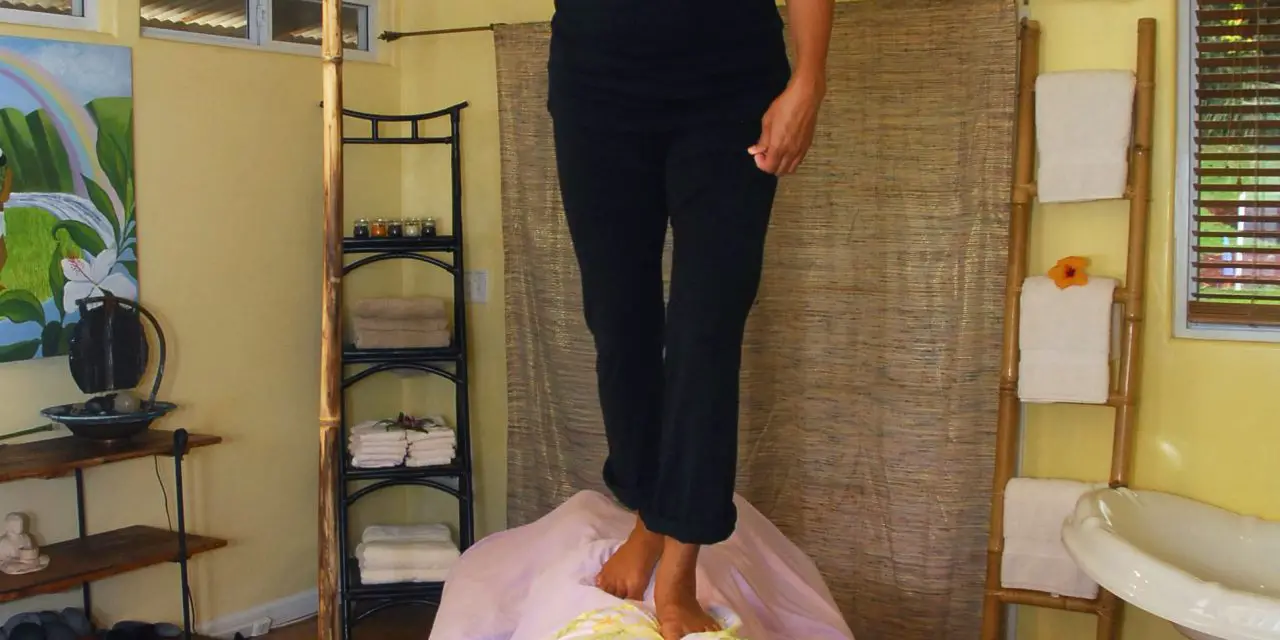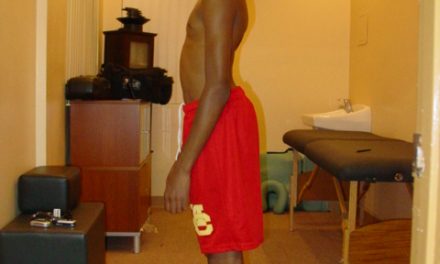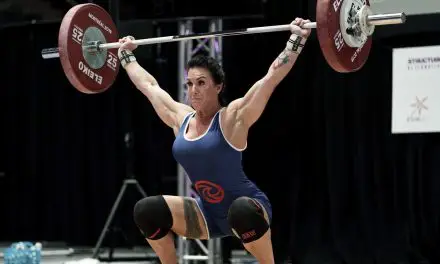Lomi lomi massage is part of the traditional Hawaiian healing practice that uses different techniques to address many of your body’s pains. It’s not a single style of massage, but rather has many different unique linages, each with its own techniques, preferences, and focuses.
Lomi lomi done by native Hawaiians in Hawaii often appears very different than the ones provided in spas outside of Hawaii. Some lomi lomi lineages have noticeable overlap with massage techniques used in the more-familiar Swedish massage.
Depending on the circumstances and the practitioner’s training, lomi lomi is sometimes done with the client fully clothed and at other times with the receiver unclothed and draped.
Many lomi lomi lineages include energetic practices. Some lineages use techniques done with the feet which some may say resembles Ashiatsu. Some lineages are more focused on relieving or healing pain and injury.
“Temple Lomi” or “Kahuna Bodywork,” the lomi lomi lineage most well known outside of Hawaii, can be recognized by its frequent use of forearms to produce long, flowing strokes on the receiver’s body. Unlike other lomi lomi lineages, Temple Lomi is done with the body liberally oiled and sometimes with very minimal draping. Whatever the lomi lomi lineage, subtle differences exist which are often not perceptible to the untrained eye.
While it has gained worldwide popularity since the 1970s, many people don’t really know the culture and history of traditional Hawaiian medicine. It’s not a massage with pretty flowers and sheets by an ocean that you often see in Google Images. And it’s nowhere close to how actress Barbara Streisand portrayed lomi lomi in the 2004 film “Meet the Fockers.”
“Lomi” is Hawaiian for “to rub,” while “lomi lomi” is Hawaiian for “massage.” Lomi is also the therapeutic interaction—touch and social—between the practitioner and the client or patient. (That’s also where “lomi lomi salmon” gets its name where salt is rubbed onto the fish before it’s chilled in the fridge.)
But lomi lomi is more than just the dictionary definition.
“Lomi was originally the act of lovingly massaging salt into the body of your loved one who had passed away,” said Jeana Iwalani Naluai , who is a kumu (teacher) of lomi lomi and is the director and co-owner of Ho’omana Spa Maui in Makawao, Hawaii.
But that definition has evolved to the act of massaging someone with care as you would with a family member.
Traditional lomi lomi massage vs. other types of massage
Maka’ala Yates,who has taught his personal lineage of lomi lomi he named Mana Lomi® in many places worldwide, said that “problem solving” is what makes the style of lomi that he teaches different than most types of massage.
“It’s one of the most difficult to learn, to use, and to teach,” he said. “So there’s a lot of lomi that is an interesting experience, feels nice, but my shoulder still hurts, my back still hurts. It involves more than just hands-on practice. Lomi is not just limited to just hands-on practice. That’s where the misunderstanding is.”
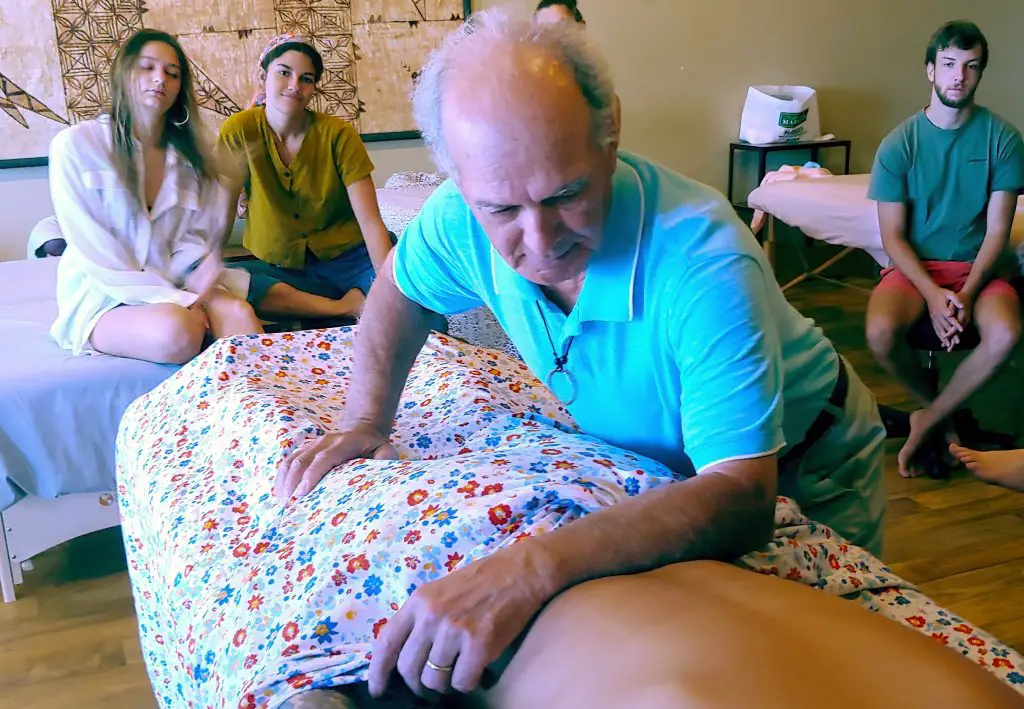
“Every time a modality comes to visit her, [Auntie Margaret] always goes back to ‘Can it beat lomi?’ So what makes lomi so different and unique that these other therapies around the world?” said Maka’ala Yates. (Photo courtesy of Maka’ala Yates.)
Auntie Margaret also taught lomi lomi to non-Hawaiians, which was unheard of at the time—similar to Bruce Lee who taught Chinese martial arts to non-Chinese in the 1960s.
The question about the differences between Hawaiian massage vs. other types of massage was something Maka’ala and Auntie Margaret had pondered for many years when they used to talk on the phone every Sunday for four years.
“She had many people from different philosophical bodies and medicine therapies that would come to her because of her popularity around the world,” Maka’ala said. “For example, Upledger Institute, where craniosacral therapy originated, the top teachers were there because they were teaching a program [in Hawaii].
“Every time a modality comes to visit her, she always goes back to ‘Can it beat lomi?’ So what makes lomi so different and unique that these other therapies around the world (not to say that other indigenous groups don’t have these qualities of lomi)?”
When asked if he recommended any modalities other than lomilomi, Maka’ala replied, “It’s not the modality that makes the difference, it’s the practitioner’s sensitivity and skill that makes the difference.”
“So how do you teach someone to feel and touch?” he continued. “In the old days, the ones who had that ‘touch,’ they were fast-tracked in learning lomi because they already had the touch. Others were slow-tracked because you have to get the hands ‘feeling’ before they can begin the work.”
One thing that Maka’ala and Auntie Margaret agreed on is the practitioner’s ability to “communicate down to the bones,” similar to shiatsu. He described our bones as an important and protected part of our structure, and “tapping” into the bones allows the practitioner to “communicate” with the client on a “soul level” for healing to take place.
“To me, lomi is universal. I call [the work that I share] Mana Lomi® to have this identity. Otherwise, I’m pigeon-holed into Hawaiian bodywork therapy whether it’s authentic or not,” Maka’ala said.
Lomi lomi massage techniques
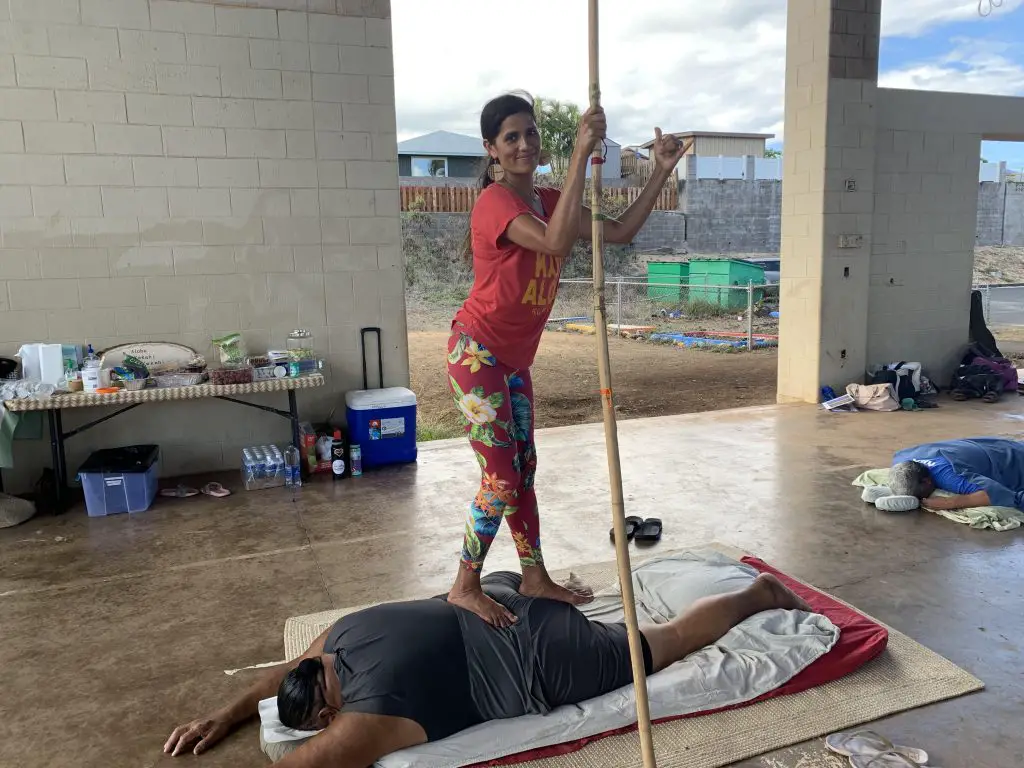
Kua lua back walking allows lomi lomi practitioners to use their feet and body weight instead of their arms and hands to do the bodywork. (Photo courtesy of Jeana Iwalani Naluai.)
Lomi lomi massage—as Jeana describes it—involves long, flowing strokes on the body. It’s similar to the effleurage and petrissage in Swedish massage but it’s often done with the practitioners’ forearm. Jeana said that they work from light to deep layers of the body.
“Usually we work in threes as we do strokes throughout the body,” she said. “In Swedish you have petrissage, which is basically a lomi lomi stroke. But in Swedish when you’re kneading, you knead from the midline to the outside. But in lomi, everything is about pushing fluids toward the heart. Proximal to distal so we open all the ‘channels’ and ‘drains.’”
She gave an example where if a client has swelling in their foot, lomi lomi practitioners would start at the hips and work their way toward the foot instead of treating the foot in the beginning.
They would use their forearms a lot for broad contact with the body, and they don’t use their fingers much like shiatsu or trigger point therapy. Lomi lomi practitioners relax their joints in the upper limbs as they glide. This relaxation allows the treatment to flow continuously.
With the stroke, the pressure goes deeper into the body to the clients’ tolerance.
“Sometimes I use a knee, stick, or an elbow,” Jeana said. “I do a style called Kua Lua which is Hawaiian back walking. I use my feet.” This allows her to work with a larger person or someone who needs really deep work without Jeana using her hands or fingers.
This type of lomi lomi described here is used and taught to others by Jeana, who carries six lineages of lomi lomi, including Maka’ala. And so, some lomi lomi practitioners may use different techniques other than what she described.
Another technique is the footwork that is adopted from both the hula (traditional Hawaiian dance) and lua (Hawaiian martial arts). Such footwork is needed to maintain the flow of the pressure and movement of the arms and hands on the body.
Like in other types of massage, the practitioner uses the footwork to shift their body weight so they can apply more (or less) pressure if needed.
In one of these footwork, the practitioner would step forward and slightly out to the side with one foot while shifting their weight forward.
Then they step back with the opposite foot and put the forward foot back to the starting position, shifting their weight to the back foot.
The pattern repeats on the opposite side. The movement somewhat resembles the basic footwork (ginga) in Brazilian capoeira.
Lomi lomi colonized and compartmentalized
Like other Polynesian cultures, the traditional Hawaiian healing practice involves herbology, prayers and chants, rituals, and lua—in addition to massage therapy.
Unfortunately, Western influence led to separation and compartmentalization of various healing practices. After initial Western contact in the late 18th century, certain members of Hawaiian royalty themselves intentionally ended the Hawaiian kapu-noa system (literally forbidden/free), a system which established all spiritual, social, and political practices and codes of conduct in Hawaii.
The kapu-noa system determined rank, how people related to each other, when, where and how people could fish or farm, what foods one was allowed to or prohibited from eating, and so much more. This overturning of kapu-noa left an immense void in the very spiritually-oriented Hawaiian community and created an opportunity and strategic opening for the influence of American missionaries who arrived within months of the kapu-noa overthrow. As a result, in the following years and decades, what was once a whole and integrated healing system was dismantled.
“The separation happened since the white man came to Hawaii. They compartmentalize a full-on practice,” Maka’ala said. “Oh, this is just massage. This is something else…this is something else, you know. You learn information on a 360-degree wheel. Lomi is just one degree of that wheel. Problem-solving lomi also involves ‘hoʻoponopono,’ the practice of living in the right way, living in balance—mind, body, and spirit.”
And the compartmentalization of lomi never resonated with Jeana.
“In Hawaii, our connection to spirit was so embedded to the land and to nature,” Jeana said. “When the missionaries came, they saw we had carved images.”
These effigies, called “akua noho,” contain the spirit of a family’s ancestor that acts as the family’s guardian. It’s also a way for a Hawaiian family to remember their ancestors, similar to ancestor worshiping in Chinese cultures.
“Before the missionaries came, we knew they were coming,” Jeana continued. “We carved images so the people wouldn’t forget during times of conquering of our islands.”
Born and raised in East Los Angeles, Jeana’s journey to her Hawaiian roots started in the early 2000s. Before she moved to Hawaii, she had studied medicine as a sports physical therapist. Because her grandmother had an influence on her view on healing, Jeana found the current medical model to be “very compartmentalized.”
“When someone has a frozen shoulder, you just get a prescription from their doctor to work on that shoulder—even though we know that the shoulder is connected to the ribcage, back, and arm,” Jeana said. “In physical therapy, everything is so regulated by the insurance companies that I would be working 10-hour days and seeing another patient every 15 minutes.”
Under insurance and the clinic’s policies, Jeana may work on a patient’s shoulder only if she has a prescription for their shoulder. But she would treat their back, neck, and arm anyways.
“I was the black sheep in the clinic,” she laughed. “They wanted [patients] to go back to their doctor and get a prescription. Otherwise, we’d be liable for working on an area that we didn’t have a prescription for.
“That didn’t make sense to me because all the practitioners that I ever learned from my family. Hawaiian practitioners were working with the whole person.”
After working five years in physical therapy, she decided to work with Auntie Margaret in 2000, who was having her last class before she retired from teaching.
Where can you learn lomi lomi massage?
In the U.S., you can learn lomi lomi massage from many Hawaiians and non-Hawaiians who have trained with a kumu, but if you want the “real deal,” well, that’s probably unlikely.
“I don’t know anyone because they’re all gone,” Maka’ala said. “The ones who are teaching are all young.”
But if there are qualities of a lomi lomi teacher that both Maka’ala and Jeana would agree based on the interviews, here’s what you should be looking for in a potential lomi lomi teacher:
Lineage
Like some Asian martial arts and Brazilian capoeira, kumu often have learned from multiple kumu, who in turn had learned from many kumu. The lineage that a kumu carries also lets people know that their work is credible and trustworthy, that they didn’t just make things up and take someone’s credit.
But don’t expect to just walk up to a kumu, fork over a wad of cash or apply for a federal loan, and “learn massage.”
“They have to see something in you first,” said Maka’ala, who carries six lineages of kumu.
He explained that for many generations on the island of Hawaii, each community in an ahupua’a was responsible for everything that happened within its pie shaped borders, including the ocean that created one side of its area. An ahupua’a is similar to a county and is comprised of a pie shaped section of land running from the mountains in the center of the island out to the ocean.
“If I went from that piece of pie to the next piece of pie, I couldn’t just go there. I have to connect with the community leaders or the connections that I have, like family members,” Maka’ala said. “It’s not about asking permission but just being aware that I would like to come and learn something. This is the old thinking.
“‘I started with Auntie Margaret and this is what I did,’ and someone says, ‘I started with Auntie Margaret and this is what I did,’ and it looks totally different. It’s still from the same person though. And Auntie Margaret has evolved from where she learned lomi. Her grandfather, Aha’ulakeali’i, was a powerful kahuna. His knowledge was passed down from Kamakanui’aha’ilona who was part of the first peoples that arrived into Hawaii.”
ʻAʻohe pau ka ʻike i ka hālau hoʻokahi. (Not all knowledge comes from one school.) ~ Hawaiian proverb
Speaking from experience
Maka’ala said that a lot of the young people who are practicing “Hawaiian cultural practices” aren’t really understanding the full scope of Hawaiian healing practice.
“What you have today is regurgitation of information. It’s not really taught,” said Maka’ala. “Through my eyes, a lot of the teachers are regurgitating information that is corrected by this teacher or that teacher or by their own family members.
“And the males took front stage all the time,” Maka’ala continued, referring to the gatherings of different tribes on the island. “None of them actually had a practice. They were regurgitating information from someone else, but Auntie Margaret was speaking from experience. That was the difference between the quality of information versus just, you know, superficial and stuff. She could go deep down the rabbit hole based on your ailment.
“None of these guys had the expertise to discuss the ailment, like what plant medicine would help that or what lomi technique would help. Auntie Margaret would just level it off like an engineer discussing how to build a 25-story building.”
Do you need to be Hawaiian to learn lomi lomi?
Because of Hawaii’s colonial history that nearly wiped out many Hawaiian traditions, it’s understandable that some kumu in the 20th century wanted to keep their art of healing secret, reserving their teachings to Hawaiians only.
But Auntie Margaret had a different opinion.
“Auntie Margaret was teaching people outside of [her] piece of pie, and that was unusual for me,” Maka’ala said. “And what was more interesting is that she was teaching to non-Hawaiians. Because Auntie Margaret and other teachers have not archived the information, it’s a free-for-all out there now. I don’t think it matters if you’re Hawaiian or not. I think the lineage you’re connected to in respect to the lineage makes a difference.”
When Jeana was a student of Auntie Margaret, there were only two Hawaiians in the entire class. Everyone else came from other parts of the world to learn from her.
“‘Aloha’ is a connection to the source, the presence of life,” said Jeana. “There are so few Hawaiians on the planet that it’s gonna take more than just us to spread this message of Aloha.”
Maka’ala is currently archiving his own teachings digitally and is working on a book tentatively titled, “The Women Kahuna,” that describes his learning experience with three female kumus.
If you’re hungry for more information about lomi lomi, visit the annual conference hosted by the ‘Ahahui Lomilomi Hawaii, formerly known as the Hawaiian Lomilomi Association. While traditionally held in Hawaii, this conference has been held via Zoom recently, making it much easier for people to attend.
Story co-edited by Barbara Helynn Robles, (aka Barbara Helynn Heard), LMT.
A native of San Diego for nearly 40 years, Nick Ng is an editor of Massage & Fitness Magazine, an online publication for manual therapists and the public who want to explore the science behind touch, pain, and exercise, and how to apply that in their hands-on practice or daily lives.
An alumni from San Diego State University with a B.A. in Graphic Communications, Nick also completed his massage therapy training at International Professional School of Bodywork in San Diego in 2014.
When he is not writing or reading, you would likely find him weightlifting at the gym, salsa dancing, or exploring new areas to walk and eat around Southern California.

